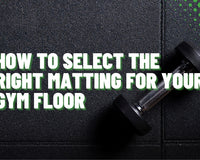If you've ever seen people at the gym standing inside what appears to be a metal hexagon with weighted plates on each side, that is a trap bar. The trap bar, otherwise known as a hex bar, is known primarily for one exercise, the trap bar deadlift.
Today, we want to take a much closer look at the trap bar deadlift, particularly the trap bar deadlift muscles worked. We'll take a closer look at each muscle that this exercise works, why it's so important, and we'll provide you with a step by step tutorial on how to do trap bar deadlifts too.
What Is a Trap Bar Deadlift?

The trap bar deadlift is a variation of the regular deadlift but instead of using a regular barbell, here you use a hex bar, otherwise known as a trap bar.
This is a special piece of weight-lifting equipment that is shaped like a hexagon, with posts on each side to hold weight plates.
You stand inside of the hexagon while holding the handles on both sides and then proceed to lift the trap bar upwards. Here, you combine elements of the conventional deadlift with the squat, providing you with many benefits.
Related Post: Find out how much a hex bar weighs
Trap Bar Deadlift Muscles Worked

One of the most important things that we want to do here is to examine which muscles that trap bar deadlift works out. Let's take a closer look.
Quadriceps
Something that you're quickly going to discover is that the trap bar deadlift is great fir targeting for your quadriceps.
Your quadriceps have to handle a lot of weight, and they handle the initial phase of the trap bar deadlift, particularly while you drive your feet into the ground.
Your quadriceps are also very important for extending your knees during this exercise. Compared to a regular deadlift, the trap bar deadlift puts a lot more emphasis on your quadriceps.
Hamstrings
The next set of muscles that get worked out by the trap bar deadlift are the hamstrings. Your hamstrings are required for both hip extension and knee flexion, both of which are required during the lockout phase during the trap bar deadlift.
However, realize that when compared to a regular deadlift with a barbell, a trap bar deadlift puts less emphasis on the hamstring and back than on the quadriceps.
Even though there's a bit less emphasis on these muscles however, they're still needed for power and stabilization.
Related Post: RDL vs Stiff Leg Deadlift
Glutes
Next on the list of muscles worked out by the trap bar deadlift are your glutes or gluteus maximus.
When it comes to hip extension, these are some of the most important muscles of all.
Hip extension is very important for the upward phase of the trap bar deadlift. If you want to target your glutes, the hip extension phase of the trap bar deadlift is excellent for this.
If you're looking to build bigger glutes, both in terms of strength and size, this is a fantastic exercise.

Lower Back
The lower back, specifically your erector spinae muscles are also worked out to a high degree when doing a trap bar deadlift.
These muscles help you to extend your spine and maintain the best posture during the trap bar deadlift.
Realize however that when compared to a regular deadlift with a barbell, less stress is placed on the erector spinae and lower back due to the body position. Therefore, the trap bar deadlift is excellent for those who have lower back problems.
Related Post: How to Do B-Stance RDLs?
Upper Back
The upper back, particularly your trapezius muscles, are also required to perform a trap bar deadlift.
This is because your trapezius muscles help to support the weight of the bar during each rep while also stabilizing your shoulders.
It might not seem like it just by looking, but the trap bar deadlift really engages your trapezius to a high degree, particularly the upper and middle fibers.
Lats
The lats, otherwise known as your latissimus dorsi muscles, are important for shoulder adduction, internal rotation, and shoulder extension.
To maintain good back tension during the trap bar deadlift, the lats will be engaged. Although this exercise doesn't directly target these muscles, they are required for proper form and stabilization.
Core
Various muscles such as your abdominals, your rectus abdominis, your obliques, and your transverse abdominis are all activated during each rep.
Your core helps to keep you stable and to maintain the right posture.
Related Post: Gorilla Rows: What are they and how to do them?
Forearms
Finally, you will need to grip the bar to lift it which in turn engages your forearms. This is especially true if you are lifting very heavy, because the heavier you lift, the more you have to grip, and your forearms will need to be strong enough to handle the load.
The Benefits of Doing Trap Bar Deadlifts
Something you might be wondering is why you would ever try doing trap bar deadlifts. Well, let's explain what all of the different benefits of doing so are.
Better for Your Back

Perhaps one of the biggest benefits of doing trap bar deadlifts is that they are much better for your back than regular barbell deadlifts.
This is because the load is centered and you are using a neutral grip, which means that there's a lot less stress being placed on your back. It's much safer for people who have back issues.
Better Quad Engagement
When compared to traditional barbell deadlifts, a trap bar deadlift engages your quadriceps to a much higher degree.
Therefore, if you want to develop big thigh muscles, then this is a great exercise for you to check out.
Improving Posture

Yet another benefit that you get from doing trap bar deadlifts is that they are excellent for your posture and stability.
Because this exercise engages your upper back muscles, your lower back muscles, and your core, it should help improve your posture, create a straighter back, and make you more stable overall.
Improving Grip Strength
Deadlifts in general are always great exercises to help to improve your grip strength.
Because you have to lift up so much weight, you need good grip strength. This in turn translates to much better performance when doing a wide variety of other exercises.
A Versatile Exercise
Something that really stands out about the trap bar deadlift is that it is extremely versatile. There are many different variations that can be done, and this means that it's a suitable exercise for many different fitness levels.
No matter the training goals you have, you should be able to incorporate the trap bar deadlift into your routine.
A Balanced Approach to Muscle Development

As this is a compound exercise which engages a wide range of muscles, it is well rounded exercise that will help you develop and well rounded physique and strength.
Overall, it's a fantastic full body exercise that can help increase your athletic performance and power.
How To Do a Trap Bar Deadlift: Step-by-Step

So you can start taking advantage of this fantastic exercise, let's go through a step by step tutorial on how to do a trap bar deadlift.
- First position the trap bar properly on the floor. Stand in the center of it and keep your feet roughly at hip width.
- Bend down at the knees and hips to lower yourself down, and hold the handles firmly using a neutral grip, which means that your palms are facing your body.
- You need to align your body, which means that your shoulders need to be directly over or in front of those handles, along with a puffed out chest and a back straight. You also want to tighten your core muscles at this time.
- To do the lift, just like with a regular deadlift, push into the ground with your heels and extend at the knees. Your shoulders and hips should rise simultaneously.
- After the trap bar passes your knees, you'll want to drive your hips forward so you can stand upright. When you are at the top of the movement, for a bit of an extra challenge, squeeze your glute muscles.
- The only thing left to do now is to lower the trap bar back down in a controlled manner by bending at your knees and hips. Make sure that you maintain proper form all throughout this exercise, and aim for anywhere between 8 and 12 reps, for up to three sets.
Safety Tips for Doing Trap Bar Deadlifts
Although trap bar deadlifts are much better for your back than regular deadlifts, there are still some safety concerns that you need to keep in mind.
- To reduce the load on your lower back, keep the bar close to your body all throughout the lift.
- Do not arch or round the spine, as this can cause damage or injury. Your spine should stay neutral.
- Although your feet should be at hip width, you can place them slightly narrower or wider to see what works best for you. If you feel your knees hurting, it might be time to change position.
- Make sure to warm up before performing this exercise.
- Before you start trying to lift several hundred pounds, start light, just so you can get the proper form down.
- While you should stand up straight at the top of the lift, don't hyperextend your lower back.
- If you feel that your back starts to hurt excessively, then you need to call it a day.
How to Get the Most Out of Your Trap Bar Deadlifts
Let's just go over some quick tips on how to get the most out of your trap bar deadlifts.
- Slowly increase the weight that you're lifting so you are continuously challenged, known as progressive overload.
- If you want to improve both your technique and strength when doing the trap bar deadlift, you need to practice it on a regular basis.
- Remember that both rest and recovery, as well as proper nutrition always play big roles when it comes to mastering any exercise, particularly in terms of growing in size and strength.
Related Post: Coventional Deadlift vs Sumo Deadlift: Which is Better?
Rounding Up

The bottom line is that if you are looking to strengthen the muscles in both your lower body and upper body, then the trap bar deadlift is a great variation of the regular deadlift to try.
It puts less strain on your back and puts greater pressure on your quadriceps, therefore resulting in some big and bulky front thigh muscles.





